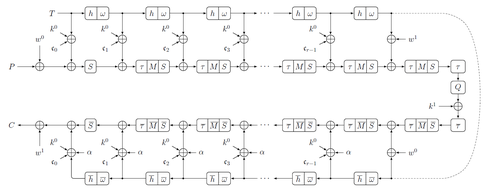Architecture

QARMA is an Even–Mansour cipher using three stages, with whitening keys w0 and w1 XORed in between:
- permutation F is using core key k0 and parameterized by a tweak T. It has r rounds inside (r = 7 for QARMA-64, r = 11 for QARMA-128);
- "central" permutation C is using key k1 and is designed to be reversible via a simple key transformation (contains two central rounds);
- the third permutation is an inverse of the first (r more rounds).
All keys are derived from the master encryption key K using specialisation:
- K is partitioned into halves as w0 Concatenation k0, each will have halfsize bits;
- for encryption w1 = (w0 >>> 1) + (w0 >> (halfsize-1));
- for encryption k1 = k0;
- for decryption, the same design can be used as long as k0+α is used as a core key, k1 = Q•k0, w1 and w0 are swapped. α here is a special constant and Q a special involutary matrix. This construct is similar to the alpha reflection in PRINCE.

The data is split into 16 cells (4-bit nibbles for QARMA-64, 8-bit bytes for QARMA-128). Internal state also contains 16 cells, arranged in a 4x4 matrix, and is initialized by plaintext (XORed with w0). In each round of , the state is transformed via operations :
- is ShuffleCells, a MIDORI permutation of cells ([ 0, 11, 6, 13, 10, 1, 12, 7, 5, 14, 3, 8, 15, 4, 9, 2]);
- is MixColumns: each column is multiplied by a fixed matrix M;
- is SubCells: each cell is transformed using an S-box.
The tweak for each round is updated using :
- is a cell permutation from MANTIS ([ 6, 5, 14, 15, 0, 1, 2, 3, 7, 12, 13, 4, 8, 9, 10, 11]);
- is an LFSR applied to each of the cells with numbers [0, 1, 3, 4, 8, 11, 13]. For QARMA-64, the LFSR is (b3, b2, b1, b0) ⇒ (b0 + b1, b3, b2, b1), for QARMA-128, (b7, b6, ..., b0) ⇒ (b0 + b2, b7, b6, ..., b1),
The rounds of consist of inverse operations . Central rounds, in addition to two rounds ( and ), include multiplication of the state by an involutary matrix Q.











